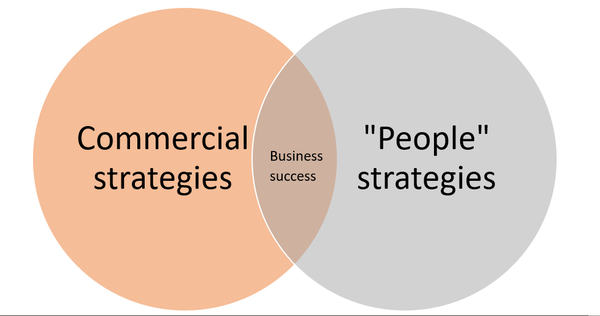THE WORLD’S #1 EXECUTIVE COACHING AND BUSINESS COACHING BLOG SINCE 2017.
The Future of Leadership Development in 2020 and Beyond
June 26, 2019 | Category: Blog, Intelligent Leadership | Last updated on: July 2, 2023
Leadership will not become easier in 2020 and beyond, though technology and automation may make certain processes faster.
Trends in the management of “human capital” have been a topic of leadership development for decades. But today more than ever, effective, engaged leaders have to stay on top of current trends influencing their company, industry, employees, and the world at large if they are to continue to produce results.
Both commercial strategies (including innovation, efficiency, and agility) and “people” strategies are evolving quickly as the world becomes more connected. It’s never been easy to identify and develop talent in next-generation leaders, but today it’s more challenging than ever due to a worldwide market where competition for talent is fierce.

Success in the 21st century requires commercial strategies as well as “people” strategies (which should include leadership development).
The development of effective leadership coaching programs is essential, and the role of leadership coaching is growing as more people realize the effectiveness of coaching in bringing leaders to maturity. In 2020 and beyond, the steps leaders take today will bear fruit.
Knowing how to develop leadership talent and when to implement coaching requires understanding changes in the business world and in the makeup of the workforce. Techniques that used to work may work no longer. Here’s what top leaders must know in order to ensure effective leadership as we move into the third decade of the 21st century.
Multiple Generations at the Top of the Leadership Chart
Around 20% of people age 65 or older are still working, and that’s the highest percentage in more than 50 years. Delaying retirement may happen for a variety of reasons, including not having sufficient savings. But on the positive side, more Americans delay retirement because they like their professional life, and increased life expectancy makes it more practical for many.
At the same time, Generation Z (the younger siblings of the Millennials, born starting in the late 1990s) are entering the workforce in increasing numbers. With up to five generations in the workforce, it’s only natural that leadership will reflect generational diversity as well. This is a good thing! The presence of different backgrounds, experiences, and perspectives in the leadership suite helps everyone think outside their own point of view, which is great for problem-solving and innovation.
Making the most of generational diversity in leadership means understanding that everyone is a person and not a statistic. But it also means understanding that different people need different things to thrive in a leadership position. Some ways that companies are maximizing the effectiveness of multi-generational leadership teams include:
- Recruiting for age-agnostic qualities – those that make sense in your corporate culture and with your goals, regardless of the age of the person possessing them
- Understanding the balance in leadership that must be struck between stimulation and stability and choosing leaders – regardless of age – who possess the qualities you need
- Experimenting with a “buddy system” pairing diverse leaders to tackle specific problems
- Ensuring CEOs make time to talk face to face with top leaders on a regular basis because it’s one of the best ways to get real feedback and understand the company’s leadership culture better
Greater Diversity in Leadership
Executive suites are more closely reflecting the diversity present in the rest of society.
Age diversity in leadership is just one manifestation of diversity in general. The good news is that more companies are trying to hire a more diverse workforce to make the best use of a broad variety of backgrounds, skills, experiences, and opinions. Unfortunately, unconscious bias still exists, and where it does, it stifles talent.
The truth is, in any consumer-focused business, diversity is one of the best ways to unleash the full potential of the workforce because a diverse workforce better understands and better reflects the consumer population. Researchers at North Carolina State University recently found that companies with diverse workforces are better at developing innovative products and services. It stands to reason that when that diversity extends to top leadership, those advantages would be amplified further.
Focus on Accountability, Transparency
Accountability matters. This has always been true and always will be true, but today, businesses simply can’t get away with a lack of accountability (for long, anyway). The world is awash in information and everyone is connected. The chances of engaging in unethical behavior and never being called to account for it are slimmer than ever. Thus, accountability matters because lack of it can lead to bad PR and a tarnished reputation.
But accountability matters for bigger reasons than fear of being caught out. Accountable organizations attract accountable people, and accountable people know that sometimes it’s harder to do the right thing, but that it’s better in the long run. A culture of accountability leads to more honest feedback, forces people to follow through on commitments, keeps us grounded in reality, and prevents small problems from turning into big problems.
Leadership today, tomorrow, and always will require a commitment to accountability and transparency in our actions. Like it or not, people perform better when they know they will be held accountable for their actions. Have you heard of the “Hawthorne effect?” It was coined based on experiments in the 1920s at Hawthorne Works, a Western Electric facility near Chicago.
The experiment was simple, really: would workers be more productive if the factory were more well-lit? Workers in both the “better lighting” and the control groups were more productive during the experiment. The lighting wasn’t the differentiating factor, so what was? It was the fact that workers knew they were being observed. Human nature says we want to perform well when we’re being watched. Mature accountability means we want to perform well whether or not we’re being watched.
AI, Big Data, and Technology in the Executive Suite
For the most part, it won’t be the people in executive leadership who will implement artificial intelligence and big data analysis in their organizations. They hire data scientists and programmers for that. But make no mistake: AI, big data, and technological advancements, in general, will have an effect on senior leadership, and leadership development programs must take these technological trends into account.
AI and big data may not make executive decisions, but they can inform them in new ways.
Both AI and big data analysis inform decision-making, and some of those decisions will take place at the executive level. The important thing to remember is that neither AI nor big data will make decision-making easier. What they do is provide more (and hopefully better) information on which to base decisions.
Actual human leaders will continue to be the ones making judgment calls, despite the impressive advances that AI and big data have made. The ability to make trade-offs, evaluate risk, and exercise good judgment based on values and goals will always be critical leadership skills regardless of technological advancement.
Change Management
Another consequence of rapid technological advancement is a faster rate of change. Resilience, agility, and adaptability are mandatory traits for tomorrow’s leaders. The ability to help organizations manage change will be increasingly important. Change management is the ability to provide a methodical approach to individuals and teams undergoing a transition from the present state to some future state.
Change management is necessary for situations such as:
- Physical relocation of a team, a branch office, or an entire business
- A major upgrade to IT infrastructure or software
- Reorganization of a department, branch, or entire business
- A merger or acquisition
Disaster preparedness is another type of change management that you hope you never have to use, but that you must be ready for, nonetheless.
When top leaders are trained and coached in change management, the entire organization can meet change with less resistance, better engagement, better performance, lower cost, and most importantly: an outcome where the organization is better than before. Change management requires discipline, and though techniques are unique to the organization, it often includes steps like:
- Identifying precisely who will participate in the change
- Identifying how groups and individuals will change
- Creating a plan for ensuring change participants have the leadership, training, and coaching they need
- Understanding how change will affect company culture and planning accordingly
- Monitoring change and addressing problems
- Tracking outcomes
- Documenting lessons learned
Innovation Departments and Teams
The process of innovation gets better with practice.
It’s great when innovation happens fortuitously, but companies cannot count on this in order to remain competitive in an increasingly innovative business environment. That’s why more businesses are creating project-based teams, and even entire departments devoted to innovation. Rarely is lack of innovation due to a lack of great ideas. Often, the problem is in evaluating, prioritizing, and executing those great ideas – a Herculean task, but one that must be accomplished to retain a competitive advantage.
There’s nothing new about businesses saying they’re in favor of innovation, but what has changed is the necessity of innovation. And without the buy-in and support of top leadership, innovation on a game-changing scale won’t happen.
Tomorrow’s leaders will have to have a keen understanding of the main types of innovation, which are product innovation, process innovation, and business model innovation. No longer will having a locked suggestion box in the break room pass as a true innovation program. Leaders must devote time and resources to innovation by employing technology (like innovation management software) and actually following up and implementing great ideas.
Succeeding with innovation requires gathering ideas, evaluating ideas, and actually implementing them.
Companies that have a commitment to innovation built into their DNA are companies that are better positioned to take advantage of opportunities and ideas, and that are in less danger of being left behind. That commitment depends on senior leadership with genuine commitment to innovation and commitment to building a strong track record of putting innovation into practice.
Agility More Important Than Ever
A Forbes Insights and Scrum Alliance survey found that 81% of executives consider agility to be the most important characteristic of a successful business. Rewards of greater agility include faster time to market, faster innovation, and improved non-financial business results (such as improved company culture).
Some businesses are even changing leadership hierarchies to accommodate agility. The same survey found that 44% of businesses have introduced flatter management structures in order to be more adaptable. Clearly, we have entered an age of agility in business, and it starts at the very top.
The CEO and other C-level leaders must play their part in driving the adoption of agile practices throughout the enterprise. This requires that they themselves embrace a mindset of agility and understand the importance of remaining flexible.
At the level of the front-line employee, agility means that some managers will have to change from telling employees what to do and how to do it to focusing on mission-critical initiatives and removing organizational impediments that prevent employees from achieving the best results. It’s not easy, especially for more traditional managers. But embracing agility is no longer an option among organizations that plan to seize opportunities and move forward out of their comfort zones.
Employee Engagement
Employees who are engaged in their work add more value than those who are disengaged.
Why should top leaders care whether their employees are engaged in their work, as long as the work gets done? There are innumerable reasons, but there are two that are especially important. Employees who are highly engaged in their work are likelier to add discretionary effort and go that extra mile to ensure excellence. And a highly engaged workforce has lower turnover, saving the company tremendous amounts of time and money.
Unfortunately, employee engagement is still abysmally low in America: 34%, according to a Gallup survey. But this is actually higher than it’s ever been, which is good news. Here are some of the reasons why leadership development programs must emphasize employee engagement.
- Profitability is 21% higher for highly engaged teams
- Most HR leaders agree that peer feedback (a hallmark of engagement) is necessary for successful outcomes
- Employees who believe they are listened to are 4.6 times likelier to feel empowered to perform at their peak
- Ninety-six percent of employees believe that empathy improves employee retention
- Disengaged employees cost companies in the U.S. some $550 billion per year
Succession Planning
Let’s be honest: succession planning isn’t much fun. In the real world, however, organizations always operate in a context that is in flux. Competition changes, the marketplace changes, and there’s no such thing as certainty. The unexpected can happen as well, in the form of an unexpected resignation or an unexpected death. Without proper succession planning, changes are far more disruptive and painful.
Leadership development programs must at least touch upon the importance of succession planning. Executive leaders must commit to succession planning as part of “business as usual,” and they must view top-level leadership as something that is dynamic, not static. Here are steps companies can take to prepare leadership for inevitable changes:
- Institutionalize a data-driven succession planning process to prevent bias
- Identify criteria and qualities essential to a new executive leader’s success
- Create an onboarding and transition process for leaders transitioning to new positions
- Emphasize the importance of long-term leadership development
- Revisit leadership criteria as the business evolves
Conclusion
Success tomorrow depends on recognizing and developing leadership talent today.
More is being asked of leadership, and more will be asked of leadership as we arrive in the year 2020 and beyond. Therefore, neglecting leadership development programs and leadership coaching is tantamount to neglecting the entire organization. The era of the monolithic company that remains the same or changes slowly over the decades is over. Never before have we lived in such a fast-paced business environment.
Leadership must be ready, and leadership development programs must identify leadership potential and performance early and offer genuine assistance to those talented people so they can become highly effective leaders. Yesterday’s leadership development programs are insufficient to the demands of today’s leadership. Leadership coaching will play an increasingly important role too, as people enter leadership roles with expectations that they will get up to speed and deliver results as quickly as possible.
It sounds like a lot of moving parts for the leader of the future to manage, and it is! But regardless of how much leadership potential a person has, putting them into a leadership position without proper training and preparation is asking for disaster. That’s why leadership development programs and leadership coaching are absolutely essential to the business that is committed to success in this fast-paced, technologically evolving era.
Glossary of Terms
Accountability – the practice of working with integrity, holding others and oneself responsible for decisions, behaviors, and actions
Agility – the ability of an individual, team, or organization to sense changes and respond accordingly and quickly
Change management – a systematic approach to anticipating and executing change in an organization to minimize problems, maximize benefits, and support affected people throughout
Employee engagement – the emotional connection between an employee and their work, which makes them want to excel and more prone to apply discretionary effort
Innovation management – an approach to innovation of products, processes, or business models that encourages innovative ideas and also puts real support and resources behind development of the best of those ideas
Succession planning – a systematic process of recognizing future leaders and planning for replacement of existing leaders when they leave the organization
Transparency – the practice of “saying what you mean and meaning what you say” in business. It represents the lack of hidden agendas and commitment to honesty








